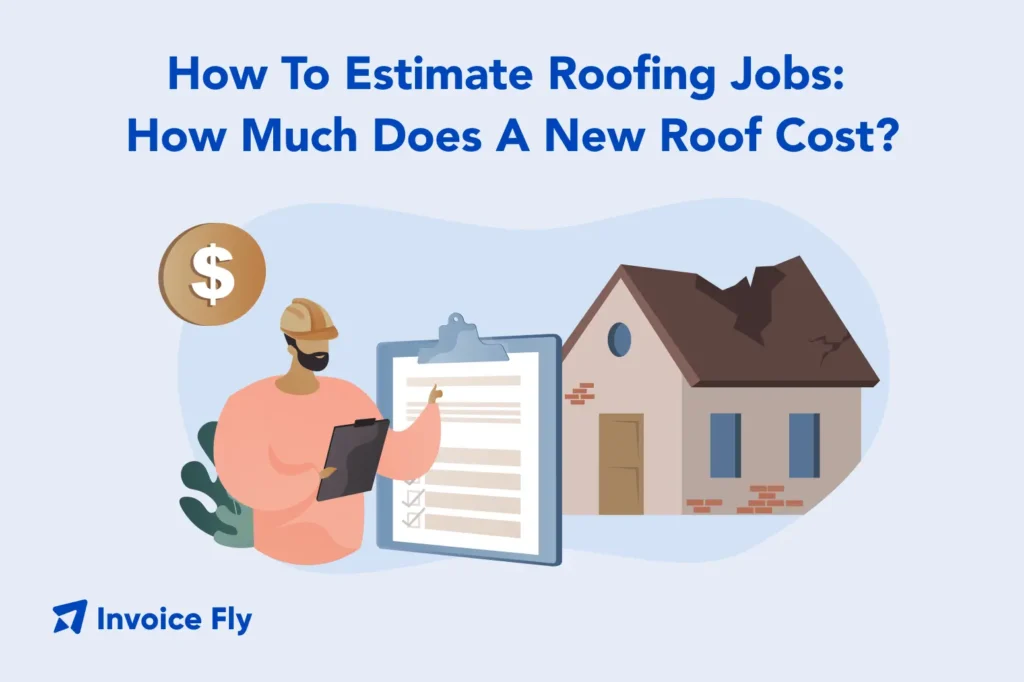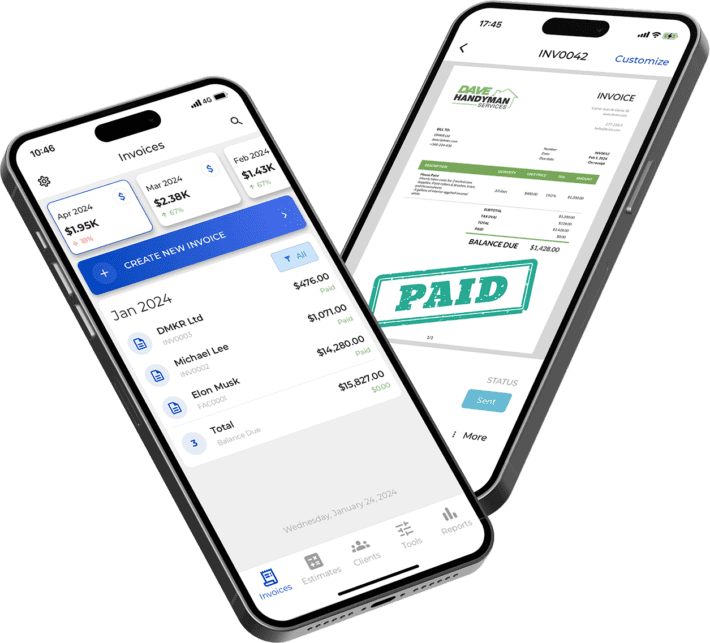Estimate Roofing Jobs: 2025 Cost Breakdown

Table of Contents
Replacing a roof is one of the biggest investments a homeowner will make, and costs can vary widely depending on size, materials, location, and labor.
According to HomeAdvisor, the national average cost to replace a roof in 2024 ranged between $5,000 and $12,000 — but in 2025, rising material and labor costs are pushing these figures even higher. Whether you’re a roofing contractor providing estimates or a homeowner budgeting for a replacement, this guide breaks down everything you need to know.
In this guide:
- The average roof replacement cost in 2025
- Key factors that impact pricing (size, material, labor)
- When to repair vs. replace
- Essential estimating tools to streamline your process
Roof Replacement Cost in 2025

So, how much does it cost to replace a roof in 2025? While prices vary depending on region, complexity, and material type, most homeowners can expect to pay between $7,000 and $15,000 with the average roof placement in the U.S now costing around $11,500. Premium roofing systems or complex installations may cost as much as $30,000.
Costs are influenced by three core factors:
- Roof size (sq ft)
- Materials used
- Labor fees based on location and roof pitch
Let’s explore each in detail.
Roof Size or Square Foot (Price Chart)
The size of the roof is the most basic cost determinant. Roofers typically measure in “squares,” where one square = 100 sq ft.
| Roof Size (sq ft) | Roofing Squares | Avg Replacement Cost |
| 1,000 | 10 | $6,500 – $9,500 |
| 1,500 | 15 | $8,500 – $13,000 |
| 2,000 | 20 | $10,000 – $15,500 |
| 2,500 | 25 | $12,500 – $18,500 |
For multi-story homes or steep roofs, extra labor costs apply.
Roofing Materials (Price Chart)
Materials make a major difference in total cost and longevity. Here’s a breakdown of average material prices per square foot:
| Material | Cost per sq ft | Lifespan |
| Asphalt Shingles | $1.50 – $5.50 | 15–30 years |
| Metal Roofing | $5.00 – $12.00 | 40–70 years |
| Tile Roofing | $6.50 – $15.00 | 50–100 years |
| Wooden Shakes/Shingles | $4.50 – $9.00 | 20–40 years |
| Slate Roofs | $10.00 – $20.00 | 75–200 years |
Source: Roofing Calculator
Asphalt remains the most cost-effective option for homeowners, while slate is chosen for luxury and longevity.
Labor Costs
Labor costs typically account for 40%–60% of the total roofing cost and vary depending on roof type and location. For example:
| Roof Type/Condition | Average Labor Cost (per sq ft) |
| Low-slope asphalt roof | $1.50–$3.00 |
| High-pitch or complex roof | $3.00–$6.00 |
| Urban areas (e.g., NYC, San Jose) | $4.00–$7.50 |
Seasonal demand, insurance costs, and local licensing requirements also impact labor pricing. For example, during storm recovery periods, demand spikes can drive prices significantly higher. In states where licensing and bonding are required, overhead increases and contractors may charge a premium.
Learn more about how these affect your business in How To Get Your Roofing License in the U.S. in 2025.
Roof Angle or Pitch
The pitch of a roof impacts safety and time required for installation:
- Low slope (less than 4/12) is easier and cheaper.
- High slope (8/12 or more) requires extra harnesses, staging, and slows down work.
Steeper roofs increase risk, require more labor, and sometimes mandate additional materials like underlayment.
Additional Roof Replacement Materials and Features
Beyond shingles or tiles, a new roof involves several other critical components that can significantly impact your total cost. These are often overlooked in initial estimates but are essential to the roof’s integrity and lifespan:
- Decking replacement: $2 – $5/sq ft. If your existing roof deck is damaged by moisture or rot, it must be replaced before new materials can be installed.
- Underlayment: $0.50 – $1.00/sq ft. This waterproof barrier adds an extra layer of protection against moisture, especially under shingles.
- Ice and water shield: $1.00 – $2.00/sq ft. This self-adhering membrane is critical in colder climates where freeze/thaw cycles lead to ice dams and leaks (Energy Star).
- Fascia and soffit replacement: $8 – $20/linear foot. These elements protect the roof edge and attic ventilation; replacing them ensures proper airflow and water resistance.
- Roof flashing & pipe boots: $5 – $15 each. Flashing seals areas around chimneys, vents, and valleys to prevent leaks; pipe boots protect vent penetrations.
Each of these features contributes to the roof’s performance and longevity. Neglecting to include them in your budget could lead to surprises down the line.
We recommend using a digital estimate tool to factor these costs in early—learn more about how in our section on roofing software tools.
Should You Repair or Replace Your Roof?
A full roof replacement is a major investment—but it’s not always necessary. Sometimes a timely repair can buy you years of added protection without breaking the bank.
According to the National Association of Realtors, homeowners can expect to recoup up to 60% of their roof replacement cost at resale, so timing your decision wisely matters.

Here’s how to determine which path makes the most sense:
Signs You Should Repair Your Roof:
- It’s a newer roof: the roof is less than 15 years old and within its expected lifespan
- Damage is minor (e.g., one or two missing shingles)
- Issues are limited to flashing or small sections—not the entire surface
- You’ve recently replaced other components (e.g., decking or underlayment)
- You’re working with a tight budget and need a temporary fix
Signs You Should Replace Your Roof:
- Your roof is over 20–25 years old or past warranty
- There are visible sagging areas or widespread curling, buckling, or moss growth
- Multiple leaks or water stains suggest internal damage or mold
- Repairs would cost more than 30%–50% of a full replacement
- Your insurance company requires it after an inspection
When in doubt, a professional inspection can help you assess the decking, attic ventilation, and moisture levels.
For pricing help, read our detailed breakdown: How To Bid A Roofing Job: Roofing Pricing Guide

Use Software to Quickly Estimate Roofing Projects
Manual estimates leave too much room for error. With roofing estimate software like Invoice Fly’s Invoice Maker, you can:
- Auto-calculate square footage pricing
- Add material markups and labor fees
- Track job timelines in real-time
- Generate printable or digital estimates on the go
It’s a powerful tool for small businesses looking to improve customer service, save time and boost conversion rates.
Final Thoughts
Roof replacement isn’t a one-size-fits-all job. Factors like square footage, roofing materials, labor rates, and roof pitch all come into play. And with costs continuing to rise in 2025, homeowners and contractors alike need clear, data-driven estimates to stay ahead.
FAQs about HVAC Marketing Strategies
1. What’s the most affordable roofing material in 2025?
Asphalt shingles remain the most budget-friendly choice for small businesses and homeowners alike. They offer a broad range of colors and finishes, making them a popular choice for replacing your roof while keeping costs low.
2. How long does a roof replacement take?
Most asphalt shingle roof replacements take 1–3 days for average-sized homes. For pitched roofs, larger properties, or upgrades involving additional features like fascia and soffit replacement or ice and water barriers, expect up to a week.
3. Is roof replacement tax deductible?
Generally, no. Roof replacements are considered home improvements. However, installing energy-efficient roofing systems may qualify you for federal tax credits. See the IRS Energy Incentives page for updated guidelines.
4. Should I get multiple quotes for my roof?
Yes. Get at least 2–3 written estimates from licensed roofing companies. Compare total costs, timeline, types of roof materials used, insurance coverage, and customer service reviews.
Absolutely. Many contractors partner with lenders to offer financing plans. You can also consider personal loans or a home equity line of credit (HELOC).
6. What factors influence the average cost of a new roof?
The total cost depends on square footage, roofing materials, roof deck condition, local labor rates, and whether any additional features like roof flashing or pipe boots are needed. Insurance companies may also affect your out-of-pocket expenses if your replacement is related to storm or water damage.
7. What’s the difference between repairs or replacements?
Roof repairs address minor issues like damaged shingles or leaks in isolated areas—ideal when the damage is minor, the underlying structure is sound, and a newer roof. Replacement is required when there’s structural damage, widespread wear and tear, or it’s time to replace based on age or inspection.


